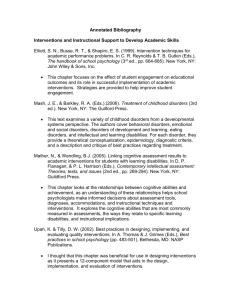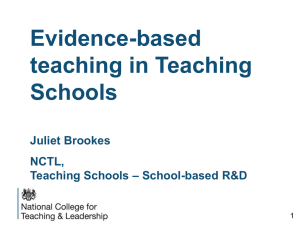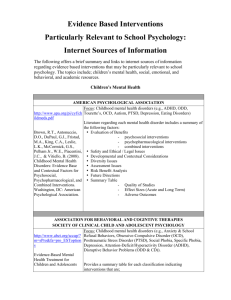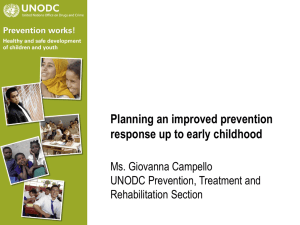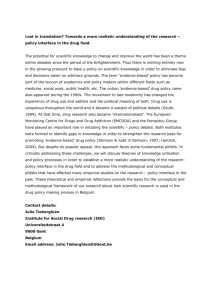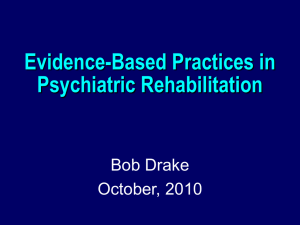Available through Sakai.unc.edu/portal – 4:50 PM COURSE:
advertisement
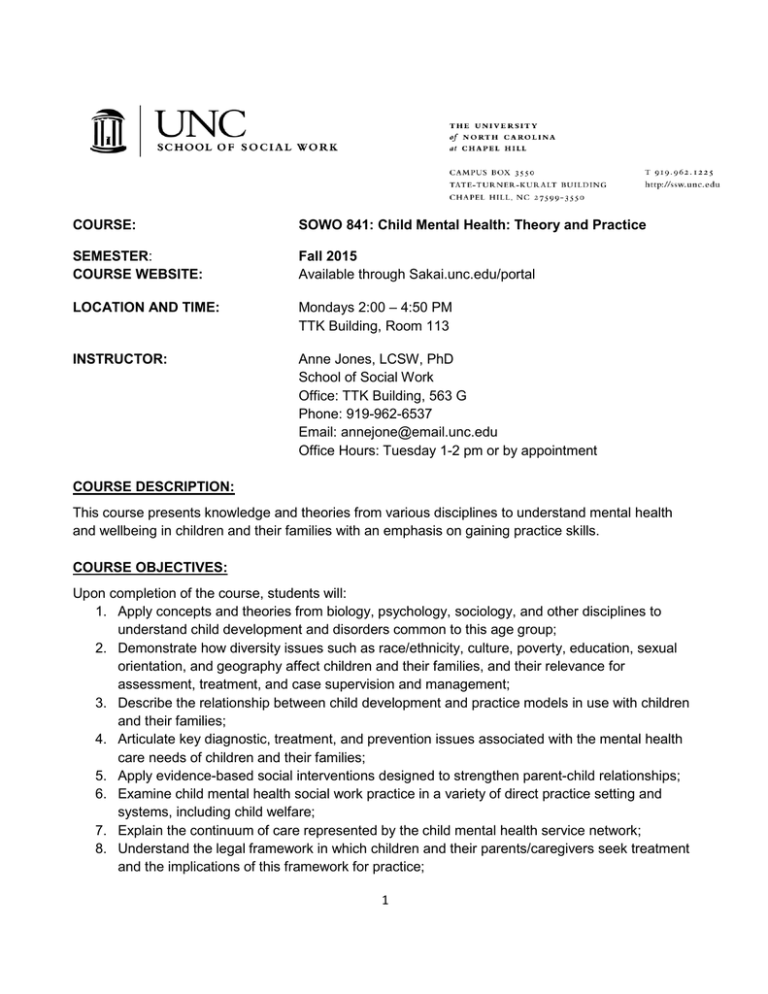
COURSE: SOWO 841: Child Mental Health: Theory and Practice SEMESTER: COURSE WEBSITE: Fall 2015 Available through Sakai.unc.edu/portal LOCATION AND TIME: Mondays 2:00 – 4:50 PM TTK Building, Room 113 INSTRUCTOR: Anne Jones, LCSW, PhD School of Social Work Office: TTK Building, 563 G Phone: 919-962-6537 Email: annejone@email.unc.edu Office Hours: Tuesday 1-2 pm or by appointment COURSE DESCRIPTION: This course presents knowledge and theories from various disciplines to understand mental health and wellbeing in children and their families with an emphasis on gaining practice skills. COURSE OBJECTIVES: Upon completion of the course, students will: 1. Apply concepts and theories from biology, psychology, sociology, and other disciplines to understand child development and disorders common to this age group; 2. Demonstrate how diversity issues such as race/ethnicity, culture, poverty, education, sexual orientation, and geography affect children and their families, and their relevance for assessment, treatment, and case supervision and management; 3. Describe the relationship between child development and practice models in use with children and their families; 4. Articulate key diagnostic, treatment, and prevention issues associated with the mental health care needs of children and their families; 5. Apply evidence-based social interventions designed to strengthen parent-child relationships; 6. Examine child mental health social work practice in a variety of direct practice setting and systems, including child welfare; 7. Explain the continuum of care represented by the child mental health service network; 8. Understand the legal framework in which children and their parents/caregivers seek treatment and the implications of this framework for practice; 1 9. Demonstrate competence in professional documentation and communication of clinical material. For each disorder covered, the course will review what is known about the phenomenology of the disorder, its prevalence, risk factors, co-morbidity with other disorders, issues related to diversity, etiology and developmental trajectory. DSM-IV criteria are examined for each disorder. Finally, the course will identify important theory that can guide practice in terms of assessment, goals, and designing/implementing effective programs of prevention and treatment. REQUIRED TEXTS: Alfano, C. A. & Beidel, D.C. (2014). (Eds.). Comprehensive evidence-based treatment for children and adolescents. Hoboken, NJ: John Wiley & Sons. (ISBN: 978-1-118-48756-3) Webb, N.C. (2011). Social work practice with children (3rd Ed.). New York: Guilford Press. (ISBN: 978-1-60918-643-2) Additional supplementary readings will be available on Sakai. These readings are will be designated with S in front of them. OTHER RECOMMENDED BOOKS: Burnett, N. & Thorsborne, M. (2015). Restorative practice and special needs. London: Jessica Kingsley Publishing. Glicken, M.D. (2009). Evidence-based practice with emotionally troubled children and adolescents. London: Elsevier. Golding, K. S. (2014). Using stories to build bridges: Creative ideas for therapist, life story work, and direct work and parenting. London: Jessica Kingsley Publishing. Malekoff, A. (2014). Group work with adolescents: Principles and practice. New York: Guilford Press. Murrihy, R.C., Kidman, D.A., & Ollendick, T.H. (Eds.) (2010).Clinical Handbook of Assessing and Treating Conduct Problems. New York: Springer: Sadock, B. J., & Sadock, V.A. (2009). Concise textbook of child and adolescent psychiatry. Philadelphia: Wolters Kluwer-Lippincott Williams & Wilkins. Sutton, C. (2006). Helping families with troubled children: A preventive approach. Chichester, West Sussex: John Wiley & Sons. ACCOMMODATIONS FOR STUDENTS WITH DISABILITIES: Students with disabilities, which affect their participation in the course, should notify the instructor if they wish to have special accommodations in instructional format, examination format, etc., 2 considered. Accommodations and services are provided by Disability Services (Voice/TDD 962-8300; 966-4041). Learning Disability Services (962-7227) provides supportive services for students with learning disabilities and attention-deficit/hyperactivity disorders. POLICY ON ACADEMIC DISHONESTY: Plagiarism in any form is not acceptable and it is a violation of the UNC Honor Code. Plagiarism is defined by the Honor code as the "the deliberate or reckless representation of another's words, thoughts, or ideas as one's own without attribution in connection with submission of academic work, whether graded or otherwise". Consulting the following website will help you to avoid it: http://ssw.unc.edu/students/writing The APA Style Guide, The SSW Manual, and the SSW Writing Guide are also good sources of information on attribution of quotes, plagiarism and appropriate use of assistance in preparing assignments. All written assignments should contain a signed pledge from you stating that, "I have not given or received unauthorized aid in preparing this written work". In keeping with the UNC Honor Code, if reason exists to believe that academic dishonesty has occurred, a referral will be made to the Office of the Student Attorney General for investigation and further action as required. POLICY ON UNEXCUSED ABSENCES: Participation will be evaluated by the degree to which students participate in class discussions, exercises, role plays and other learning activities. What does good class participation look like? It looks like someone who is interested, engaged in discussions, shares his or her opinions and observations and asks questions. It is a student who is an active participant in his or her learning and keeps up with the readings for his or herself and for the betterment of classroom learning. Attendance will be recorded and unexplained absences and/or chronic tardiness will impact participation grade. POLICY ON INCOMPLETE AND LATE ASSIGNMENTS: A grade of Incomplete is given on rare occasions when extreme circumstances warrant it. It is the student’s responsibility to initiate a conversation with the instructor to request an Incomplete. Late assignments are strongly discouraged. Without prior approval, TEACHING METHODS: Class sessions will accommodate different learning styles through a combination of lecture, discussion, videos, and experiential learning activities. I will be scheduling guest speakers as the semester progresses. ASSIGNMENTS AND GUIDELINES: Case Assessment – 20% Annotated Bibliography – 20% Reflection Paper – 20% Treatment Plan – 25% 3 Class Participation and Attendance – 15% EVALUATION OF STUDENT PERFORMANCE: The following factors are considered when determining the grade earned by each student in this course: An “H” is awarded to students whose work reflects “clear excellence” as defined by the Graduate School. “Clear excellence” means exceeding “P-level” requirements in two ways: (a) analysis & evaluation of class practice, and (b) extensive use of scholarly literature. A “P” will be awarded for completion of all requirements as set forth in this syllabus and with none of the deficiencies noted above. A “P” as defined by the Graduate School signifies entirely satisfactory work. An “L” will be assigned when a student has excessive absences or tardiness from class without justifiable reason and fails to participate in class discussions and activities. An inability to produce written work that demonstrates graduate-level skills, (e.g. excessive spelling, punctuation, grammatical, and citation errors) will also adversely affect a student’s grade. Students are expected to use a 12-point font and the reference style of the Publication Manual of the American Psychological Association. An “F” will be assigned for failing to complete any of the above-mentioned requirements as set forth in this syllabus. Total score for all assignments completed that fall below a grade of 70 also will result in a course grade of “F”. Points: 94-100 80-93 70-79 >69 Grade: H P L F 4 COURSE OUTLINE: Week 1: August 24: Introduction to Course Introductions Review syllabus and assignments The mental health needs of children today Overview of theoretical lenses used in this course Week 2: August 31 – Unique Aspects of Working with Children and Competencies Needed to Work with Them • • • • Ethical and legal considerations Multi-cultural competency Developmental considerations Family/other systems involvement Required Readings: Webb text: Chapter 1 -The Challenge of Meeting Children's Needs, pp. 3-18 Chapter 2 - Necessary Background for Helping Children, pp. 1938 Chapter 4- Building Relations with all Relevant Systems, pp. 4158 Fried, A. L. & Fisher, C. B. (2014). Ethical considerations in mental health treatment and interventions with school-age children and adolescents. In C.A. Alfano & D.C. Seidel (Eds.). Comprehensive evidence-based interventions for children and adolescents (pp. 15-30), Hoboken, NJ: John Wiley & Sons. September 7- Labor Day No class. Enjoy your day! Week 3: September 14 – Assessing the Child-Family System: General Guidelines Engaging the parents/care-takers Parenting profile Developmental history Collateral information Engaging the child- activities, tools and toys Culture Risk and protective factors Required Readings: Webb text: Chapter 4 - The Biopsychosocial Assessment of the Child, pp. 58-100 Przeworski A., Dunbeck, K. (2014). Development considerations in assessment and treatment. In C.A. Alfano & D.C. Seidel (Eds.). Comprehensive evidence-based interventions for children and adolescents (pp. 3-14), Hoboken, NJ: John Wiley & Sons. 5 (S) Lecroy, C.W. & Okamoto, S.K. ((2009). Guidelines for selecting and using assessment tools with children. In A. R. Roberts (Ed.), Social workers' desk reference (2nd ed., pp. 381384). New York: Oxford University Press. Optional Reading: Webb text: Chapter 5- Contracting, Planning Interventions and Tracking Progress, pp.101-117 Week 4: September 21 – Anxiety Disorders and use of CBT Prevalence Common anxiety disorders and symptoms Cognitive-behavioral treatment: basic concepts Components of evidence-based treatments Planning interventions Assignment 1 due Required Readings: Seligman, L. D., Swedish, E. F. & Ollendick, T. H. (2014). Anxiety disorders in children. In C.A. Alfano & D.C. Beidel (Eds.). Comprehensive evidence-based interventions for children and adolescents (pp. 93-109), Hoboken, NJ: John Wiley & Sons. (S) Sutton, C. (2006). Helping families with troubled children: A preventive approach. Chichester, West Sussex: John Wiley & Sons. Chapter 2 – Social Learning/Cognitive-behavioural Theory, pp. 33-67. (S) Connolly, S.D., Bernstein, G. A., & the Work Group on Quality Issues. (2007). Practice parameter for the assessment & treatment of children and adolescents with anxiety disorders. Journal of the American Academy of Child Adolescent Psychiatry. 46(2), 267-283. doi:10.1097/01.chi.0000246070.23695.06 Optional Reading: Greco, G.A. & Morris, T.L. (2004). Assessment. In T.L. Morris & J.S. March (Eds.). Anxiety disorders in children and adolescents (2nd ed, pp. 98-124), New York: Guilford Press. Week 5: September 28 – Depressive Disorders Prevalence Common depressive disorders and symptoms Factors that contribute to depression in childhood Components of evidence-based treatments Practice and reflection Required Readings: 6 Chung W.W. & Fristad, M.A. (2014). Depressive disorders in Children. In C.A. Alfano & D.C. Beidel (Eds.). Comprehensive evidence-based interventions for children and adolescents (pp. 129146), Hoboken, NJ: John Wiley & Sons. (S) Sutton, C. (2006). Helping families with troubled children: A preventive approach. Chichester, West Sussex: John Wiley & Sons. Chapter 6 – Helping Families with Children who are Anxious or Depressed, pp. 131-157. (S) Center for Health and HealthCare in Schools. (2007). Psychotropic drugs and children: A 2007 update. Saint Louis, MO: The School of Public health and Health Services, The George Washington University. Retrieved from http://www.healthin schools.org/*/media/1F79BC0050C64BF9B79EAB1FD0A21D21.ashx. Week 6: October 5 – ADHD & Working with Parents Overview of the disorder Prevalence and Co-morbidity Evidence-based treatments Levels of family involvement Behavioral Parent Training Required Readings: Webb text: Chapter 6 – Working with the Family, pp.121-148 Powell, N. P., Lochman, J E., Boxmeyer, C L., Jimenez-Camargo, L. A., Crisler, M. E. & Stromeyer, S. L. (2014). Evidence-based treatment of attention deficit-hyperactivity disorder in children and adolescents. In C.A. Alfano & D.C. Beidel (Eds.). Comprehensive evidence-based interventions for children and adolescents (pp. 180-193), Hoboken, NJ: John Wiley & Sons Prinz. R. (2009). Behavioral parent training. In H. Reis & S. Sprecher (Eds.) Encyclopedia of human relationships (pp. 156-159). Thousand Oaks, CA: SAGE Publicatios, Inc. http://dx.doi.org.libproxy.lib.unc.edu/10.4135/9781412958479.n53 Week 7: October 12 - Conduct and Disruptive Behavior Disorders and Intensive In-Home Interventions Overview of conduct disorders Overview of evidence-based approaches Parent-training for young children A family-based approach for older children Required Readings for next class: Jones, H. A. &. Rabinovitch A. E. (2014). Treatment of conduct problems and disruptive behavior disorders. In C.A. Alfano & D.C. Beidel (Eds.). Comprehensive evidence-based interventions for children and adolescents (pp.195-212), Hoboken, NJ: John Wiley & Sons. 7 (S) McMahon, R. J., Long, N. & Forehand, R.L. (2010) Parent Training for the Treatment of Oppositional Behavior in Young Children: Helping the Noncompliant Child. In R. C. Murrihy, A. D. Kidman & Thomas H. Ollendick (Eds.) Clinical Handbook of Assessing and Treating Conduct Problems (pp.163-192), New York: Springer. (S) Alexander, J.F. & Robbins, M.S. (2010). Functional Family Therapy: A Phase-Based and MultiComponent Approach to Change In R. C. Murrihy, A. D. Kidman & Thomas H. Ollendick (Eds.) Clinical Handbook of Assessing and Treating Conduct Problems (pp.245-272), New York: Springer. (S) Lochman, J. E., Boxmeyer, C., Powell, N.P., & Wells, K.C., (2010). Cognitive behavior therapy for the group-based treatment of oppositional youth. In R. C. Murrihy, A. D. Kidman & Thomas H. Ollendick (Eds.) Clinical Handbook of Assessing and Treating Conduct Problems (pp.221244), New York: Springer. Week 8: October 19 – Pervasive Developmental and Intellectual Development Disorders Autism spectrum disorders Intellectual development disorders and family supports Evidence-based practices Required Reading: White, S. W., Kreiser, N. l. & Lerner, M.D. (2014). Autism spectrum disorders. In C.A. Alfano & D.C. Beidel (Eds.). Comprehensive evidence-based interventions for children and adolescents (pp.195-212), Hoboken, NJ: John Wiley & Son. (S) Sadock, B.J. & Sadock, V.A. Concise textbook of child and adolescent psychiatry. Philadelphia: Wolters Kluwer-Lippincott Williams & Wilkins. Chapter 2 – Mental Retardation, pp. 13-32. (S) Salvador-Carulla L, Reed GM, Vaez-Azizi LM, Cooper SA, Martinez-Leal R, Bertelli M, et al. (2011). Intellectual developmental disorders: Towards a new name, definition and framework for “mental retardation/intellectual disability” in ICD-11. World Psychiatry, 10, 175–80. Week 9: October 26: Introduction to Play therapy and Applications to Work with Children Affected by Violence and Trauma Rationale for play therapy Assignment Two Due Basic techniques and materials Applications to work with violence and trauma Dealing with personal reactions Required Readings: Webb text: Chapter 7 – Individual Play Therapy, pp. 149-173. Chapter 14 – Child Victims and Witnesses of Family and Community Violence, pp. 328354. 8 (S) Perry, B.D. (2001). The neurodevelopmental impact of violence in childhood. In Textbook of Child and Adolescent Forensic Psychiatry, (Eds., D. Schetky & E.P. Benedek) American Psychiatric Press, Inc., Washington, D.C. pp. 221-238, 2001 Fisak, B. (2014). Trauma-related problems and disorders. In C.A. Alfano & D.C. Beidel (Eds.). Comprehensive evidence-based interventions for children and adolescents (pp.287- 300), Hoboken, NJ: John Wiley & Sons. Optional Reading: (S) Golding, K. S. (2014). Using stories to build bridges: Creative ideas for therapist, life story work, and direct work and parenting. London: Jessica Kingsley Publishing. Chapter 1 – The Power of Stories to Facilitate Healing for Children and their Families, pp. 2631 Chapters 2 – Creating your own Helping Stories (S) Shaw, J. A. (2003). Children exposed to war/terrorism. Clinical Child and Family Psychology Review, 6(4), 237-246. doi: 10.1023/B:CCFP.0000006291.10180.bd (S) Montgomery, E. (2010). Trauma and resilience in young refugees: A 9-year follow-up study. Development and Psychopathology, 22(2), 477-489. doi: 10.1017/S095457941000 Week 10: November 2 – Group Work with Children and Applications to Divorce and Rational for using groups with children Types of groups Considerations in planning a group Activities for promoting social skills, self-esteem etc. Required Reading for: Webb text: Chapter 9 – Group Work with Children, pp. 174-198. (S) Bonkowski, Sara (2005). Group work with children of divorce. In G.L.Greif and P.H. Ephross (Eds.) Group work with populations at risk (2nd ed., pp. 135-146). New York: Oxford Press. (S) Malekoff, A. (2014). Group work with adolescents: Principles and practice. New York: Guilford Press. Chapter 9 – The Purposeful use of Activities in Group work: Innovative, Expressive, and Mindful Approaches, pp. 194-219. Optional Reading: (S) Malekoff, A. (2014). Group work with adolescents: Principles and practice. New York: Guilford Press. Chapter 3 – Strengths-Based Group Work with Adolescents, pp. 41-68. Week 11: November 9 – Issues of Child Abuse and Neglect Assessing for abuse and need for placement Common issues for children in placement Evidence-based interventions 9 Required Readings for Next Week: (S) Rycus, J.S. & Hughes, R.C. (2009). Recognizing indicators of child maltreatment. In A. R. Roberts (Ed.), Social workers’ desk reference (2nd ed., pp. 659-665). New York: Oxford University Press (S) O’Hare, T. (2015). Evidence-based practices for social workers, 2nd Ed. Chicago: Lyceum Books. Chapter 14: Child abuse and Neglect, pp. 519 – 577. (long chapter; if pressed for time read up to 559). (S) Neubauer, F. & Deblinger, E. & Sieger, K. (2015) Trauma‐Focused Cognitive‐Behavioral Therapy for Child Sexual Abuse and Exposure to Domestic Violence. In N. Boyd Webb (Ed.) Play therapy with children and adolescents in crisis (4th ed, pp. 118-139). New York: Guildford Press Optional Reading: (S) Kraus, L.J. & Thomas, R.T. (2011). Practice parameter for child and adolescent forensic evaluations, Journal of the American Academy of Child & Adolescent Psychiatry, 50(12), 12991312 (S) Thomlison, B. (2004). Child Maltreatment. A risk and protective factor perspective, 2nd Edition. In M. Fraser (Ed.), Risk and resilience in childhood: An ecological perspective (pp. 89-132), Washington: NASW Press. Webb text: Chapter 10 – Children Living in Kinship & Foster Home Placements, pp. 227-248. (S) Lavner, J. A., Waterman, J. & Peplau, L. (2014). Parent adjustment over time in gay, lesbian, and heterosexual parent families adopting from foster care. American Journal of Orthopsychiatry, 84(1), 46-53. Doi: 10.10371h0098853 Week 12: November 16-– School Related Problems and Interventions Prevalence and strategies to address bullying Prevalence and strategies to address chronic school absenteeism Working with GLBT children Facilitating home-school-community partnership Assignment Three Due Required Reading for next week: Webb text: Chapter 9 – School-based interventions, pp. 199-224. Chapter 15 – The Interpersonal Violence of Bullying: Impact on Victims, Perpetrators and Bystanders/Witnesses Kearney, C.A. & Ross, E. (2014). Problematic school absenteeism. In C.A. Alfano & D.C. Beidel (Eds.). Comprehensive evidence-based interventions for children and adolescents (pp.275283), Hoboken, NJ: John Wiley & Sons. 10 (S) Glicken, M.L. (2009). Evidence-based practice with emotionally troubled children and adolescents. London: Elsevier Inc. Chapter 12 - Evidence-based practice with gay, lesbian, bisexual and transgender children and adolescents, pp. 201-215. Optional Reading: (S) Fong R, Armour, M., Busch-Armendariz, N., & Heffron, LC. (2009) Case management interventions with immigrant and refugee students and families. In A R. Roberts (Ed.), Social workers' desk reference (2nd ed., pp. 70-76). New York: Oxford University Press. (S) No author. (2015). Refugee Children in the U.S. Schools: A Toolkit for Teachers and School Personnel. Retrieved from: http://www.brycs.org/publications/schools-toolkit.cf Week 13 November 23 – Eating Disorders and Obesity Overview and prevalence Types of disorders Evidence-based treatments Required Reading: Doyle, P.M., Byrne, C., Smythe, A. & Legrange, D. (2014). Evidence-based interventions for eating disorders. In C.A. Alfano & D.C. Beidel (Eds.). Comprehensive evidence-based interventions for children and adolescents (pp.231-242), Hoboken, NJ: John Wiley & Sons. Optional Reading Vannucci, A. & Tanofsky-Kraff, M. (2014). Overweight and obesity. In In C.A. Alfano & D.C. Beidel (Eds.). Comprehensive evidence-based interventions for children and adolescents (pp.335352), Hoboken, NJ: John Wiley & Sons. Week 14: December 1 – Your choice of topics Wrap up Feedback on the course Celebrate Assignment Four is due in one week – December 7th 6:00 pm 11 ASSIGNMENT DESCRIPTION Submission of assignments: I prefer to work paperless so please submit your assignments through Sakai using the Assignments Tab. For each due date the submission time is 6:00 pm. For the early birds, each assignment “site” will be open at least a week before it is due. You may submit one of the first three assignments late (up to one week) without requesting an extension. Assignment One: Case Assessment and Formulation Due Class 4 – 9/21/15 Objective: The purpose of this assignment is to gain further practice (1) writing an assessment, in this case involving a child that you are working with in your field placement or have worked with in the past and (2) developing a clear treatment goal. This assignment will form the basis of other assignments so please choose a topic that you are interested in and want to learn more about. I will post an outline on Sakai under the Resources/Assignment Tab. Evaluation Criteria for Assignment One Outline is appropriately followed and required information is easy to gleam. Possible Points 5 Agency and description of client and problem are clearly presented. 10 Onset and key historical factors are clearly described 15 Developmental stage and tasks and physical factors are accurate and clearly delineated. Important contextual and historical factors are identified and clearly reflected in discussion of strengths and protective factors. Impressions and summary provide a thoughtful and insightful appraisal of your client’s situation. It conveys your opinions and provides a realistic direction for what you believe should happen next. Preliminary goal(s) follows logically from the information and summary above and adheres to SMART criteria. Information is clearly and succinctly written with few or no errors. 15 Total 20 15 15 5 100 Assignment Two: Annotated Bibliography – Seeking out evidence-based information to inform your intervention plan. Due Class 9 - 0/26/15 Objective: The aim of this assignment is to gain experience in seeking out evidence in the professional literature to support your choice of interventions. There are two steps in 12 I this process. (1) Developing a client- o r i e n t e d question and (2) tracking down best evidence to answer the question. This assignment includes three parts. In part one, you will devise a question that will guide your research for part two. In part two you will do a literature search leading to an annotated bibliography that focuses on the most effective therapeutic approach(es) for the client or client system that was summarized in your assessment. Appropriate selections will include scholarly articles, book chapters, treatment manuals, conference proceedings, or governmental reports. One item may be a website. Blogs or entries from Wikipedia are not appropriate for this assignment. The annotated bib should include at least six cited articles that will answer your question(s). They should also help you to obtain: • A more detailed understanding of the kind of problem that you and your client(s) are working on. This might include information such as etiology, common characteristics/symptoms, and risk and resiliency factors. • Information about common client characteristics, e.g. gender, age, culture, race common co-existing disorders, general prognosis etc. • A standardized assessment or screening tool and other recommended kinds of data to gather such as classroom observations, parent tracking etc. • Description of at least two evidence-based interventions strategies e.g. exposure therapy, parent training, socialization group, referral for medication evaluation etc. Each annotation should be between 100-200 words, and should be directly relevant to one of the bullets listed above. The following is an example of an annotated bibliography entry that discussed treatment options for the specific population of foster children. NOTE: This annotation was completed by a student (who gave permission) in this program for a previous class, and does not ask for all the items you are expected to include for this task. Check to be sure you are including all the items required of you. Craven, P. A. & Lee, R. E. (2006). Therapeutic interventions for foster children: A systematic research synthesis. Research on Social Work Practice, 16 (3), 287-304. The authors utilize a systematic research synthesis, which features conceptual rather than statistical data integration, yielding what the authors call hypotheses or "promising hunches" (p. 288). The authors included 18 articles, each discussing a different intervention strategy. Nine articles focused on treatment while the other half aimed at prevention. The authors identified 6 strategies, 4 treatment and 2 preventive, which they identified as well-supported and efficacious. These are: Dina Dinosaur; Parent-Child Interaction Therapy, Multisystemic Therapy (MST), and Multidimensional Treatment Foster Care (MTFC) as the treatment methods, and Partners Intervention and Prenatal & Childhood Nurse Visitation as the preventive methods. Other articles in this bibliography also support the use of MTFC and MST for meeting foster youths' mental health needs. In part three of this assignment you will summarize and critically evaluate your findings. This summary should be about a page in length and pull together the information gleaned from the 13 research process. It should also include a discussion of how useful the information is and what gaps/limitations exist. Final product for Assignment Two: 1) A question regarding how best to intervene regarding your specific client and their issue and personal characteristics? 2) Six annotated citations (please double space) 3) A one page synthesis of your findings Evaluation Criteria for Assignment Two Question(s) is clear, specific to your client situation, and facilitates your ability to obtain the information needed. Six items are from appropriate resources; show effort at researching a specific problem or model specific to your client situation; bibliographic entries provide information that helps to answer your question(s) and provide relevant, up-to-date guidance on assessment and therapeutic approaches for the issue that you and your client are addressing. Annotations are well written and provide a clear sense of what the chosen item was about APA format is used correctly, Summary of findings reflect a succinct synthesis and appraisal of your findings. Gaps or conflicting information is identified. Total Possible Points 10 60 10 20 100 Assignment Three: Reflection Paper Due Class 12, November 16 Objective: The aim of this assignment is to facilitate personal reflection on the internal conflicts, biases, struggles and triggers that inevitably emerge when working with clients, especially when there are children involved. In this paper, I would like to hear from you about your reactions to one or more of the following questions. (1) How do you feel your work with your client(s) has been going and why? (2) How do you feel about your own abilities and qualifications as you have been working with this case? (3) What kinds of interactions have you had with parents/care-givers or other adults involved in the case and what have they been like for you? (4) What personal conflicts have you experienced with this situation, e.g. parents not following through. (5) What if any triggers have there been for you and how have you worked on them? (6) What if anything has surprised you during the course of this case (either about yourself or your client(s)? (7) Conclusion (required) -what have you learned about yourself as you have been involved (or were involved) in this case? 14 This is not required, but it may be helpful to do some brief journaling on your own to prepare for this assignment. If you do, this is for yourself and does not need to be handed in. Length: Approximately 3 pages, double-spaced. Evaluation Criteria for Assignment Three Paper shows high level of thoughtfulness Paper covers all or most of questions/prompts from above Assignment is well organized and written Total Points Possible Points 45 45 10 100 Assignment Four: Treatment Plan Due December 7th Objective: The aim of this paper is to integrate your findings from your annotated bibliography and other class readings with the specifics of your client's circumstances and develop an evidence-based supported intervention plan. • Utilizing the additional information obtained in your literature review, write a brief case summary explaining the client's presenting problem (from assignment #1) in light of what you have learned and factors that are highlighted in the literature (assignment #2). This is short but can be difficult. Take your time here. • Identify a measure checklists or other forms of assessment that you could use to support your conclusions or diagnosis. • Your case formulation and treatment plan should be consistent. For example, if you are working with a child (and family) diagnosed with a Conduct Disorder and are using an approach with a strong cognitive-behavioral component, you will be using terminology such as parenting management skills and problem-solving skills rather than attachment bonds and ego strength. • Write out two primary goals of the case, you may do this in bullet form. Be sure that the goals are consistent with the way in which you have now formulated the case and plan to intervene. • Choose one intervention to go with each of the goals you have listed for the case plan-An intervention is what YOU as the practitioner do to facilitate the client's success i n achieving their goals, e.g. you will provide…, refer…, model…demonstrate… etc. • Briefly discuss any practical or ethical concerns you have about what your findings as well as disconfirming evidence that came to light during your searches. These might be gaps in the research or a lack of specificity to your client characteristics, e.g. Latina. Also, discuss any identify any major barriers that could potentially impede the success of the treatment and describe your precautions against those effects. 15 Evaluation Criteria: Assignment Four Possible Points Case Formulation Your client situation is succinctly summarized and described utilizing the perspective of the treatment approach that was highlighted and supported in your literature review. In doing so, you will highlight aspects of the case that are relevant to the recommended treatment model. For example, a multisystemic therapy approach is grounded in ecological theory and suggests the need to intervene with multiple systems such as family, peers, teachers, neighbors etc. Assessment At least one form of an assessment measure is provided. This should be a standardized measurement that has been identified in the literature. In addition, other forms of assessment might include a structured interview, parent-child observations, collateral reports etc. Goals and Interventions 1. Two primary client-oriented specific goals that are linked to the assessment and intervention approach. These goals should be in accordance with SMART goal criteria. 2. One clearly articulated, congruent, evidence-based intervention is provided for each goal. Practical and Ethical Concerns or Barriers Discuss any concerns that you have about implementing the assessment and interventions that you have found. This could be a range of things including: Your agency does not lend itself to the models/interventions that you found; gaps or limitations in the literature about the problem itself, little attention given to modification of interventions for different cultures etc. Writing and APA: Writing is clear and contains few or no errors. APA format is used correctly throughout the paper and in the reference list. TOTAL 16 20 12 24 18 16 10 100 17 18

